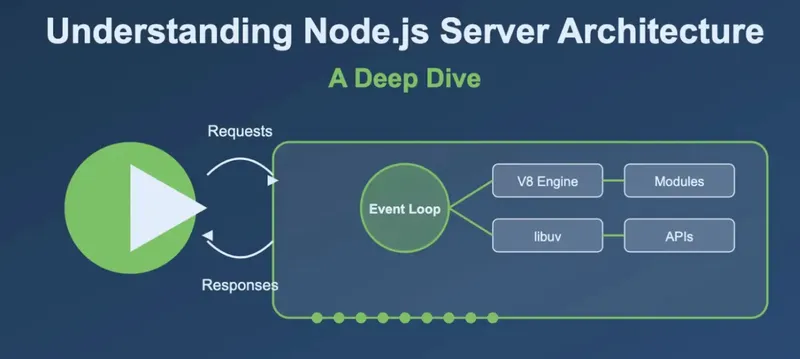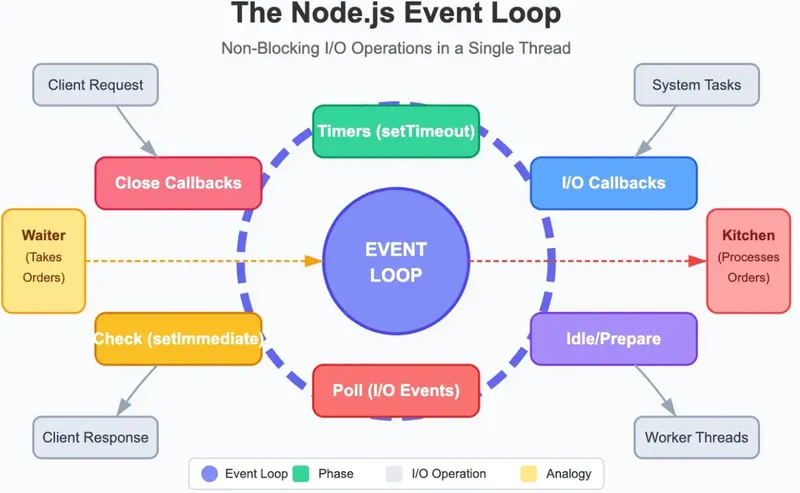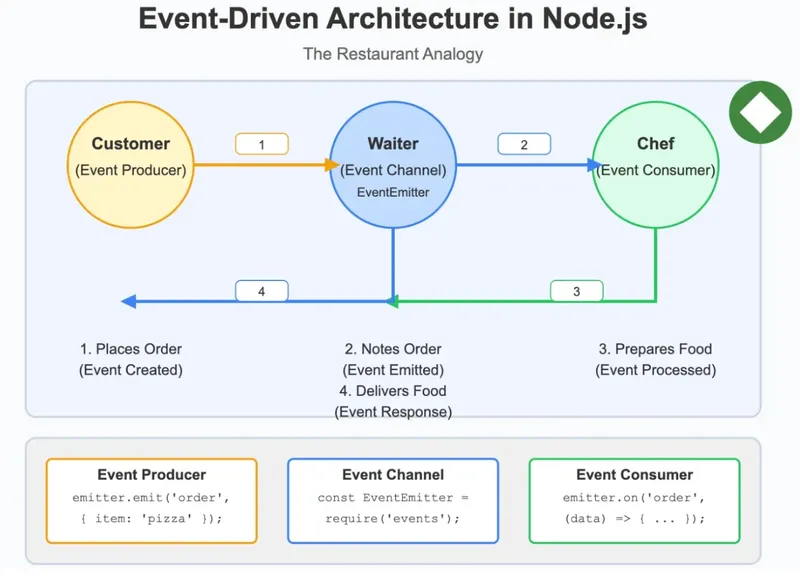Behind the Scenes: Unpacking Node.js Server Architecture
Behind the Scenes: Unpacking Node.js Server Architecture
Node.js is one of the most popular runtime environments (i.e., a runtime environment is where a program is executed and provides resources for executing the program) used for building scalable and high-performance web applications, especially on the backend. If you are a developer who builds web applications using Node.js, you might wonder what makes Node.js so powerful. In this blog, we’ll explore the architecture of a Node.js server, how it handles requests, and why it’s a great choice for modern web development.

What is Node.js?
Node.js is an open-source, cross-platform runtime environment built on Chrome’s V8 JavaScript engine (responsible for executing JavaScript code in Google Chrome and Chromium-based browsers like Microsoft Edge and Brave). It allows developers to run JavaScript on the server side, enabling the creation of fast and scalable network applications. Unlike traditional server-side technologies like PHP or Java, Node.js uses a single-threaded, event-driven architecture that makes it lightweight and efficient.
Node.js is particularly well-suited for I/O-bound applications, such as real-time chat apps, streaming platforms, and APIs. Its non-blocking I/O model ensures that the server can handle thousands of concurrent connections without breaking a sweat.
Components of Node.js Server Architecture
To understand how Node.js works, let’s break down its core components:
Event Loop
The event loop is the heart of Node.js. It’s what allows Node.js to perform non-blocking I/O operations, even though JavaScript is single-threaded. Here’s how it works:
- When a request arrives, the event loop registers a callback and delegates the task (e.g., reading a file or querying a database) to the operating system or a worker thread.
- Once the task is complete, the event loop executes the callback and sends the response back to the client.

For a better understanding of the event loop, consider the example of a waiter in a hotel who takes orders (i.e., requests) and sends the order list to the kitchen staff (i.e., the event loop). When the order is ready, the kitchen (i.e., the callback) informs the waiter, and the waiter serves the order to the customer.
Asynchronous I/O
Asynchronous I/O means that when a request arrives from the client side, the Node.js server can handle other tasks simultaneously. Once the current task is completed, it executes the new request. Imagine you’re at a restaurant:
- Customer (Client Request): A customer places an order with the waiter.
- Waiter (Node.js Server): The waiter writes down the order and immediately takes another customer’s order without waiting for the kitchen to finish cooking.
- Kitchen (Asynchronous Operation): The kitchen prepares the food in the background while the waiter continues to serve other customers.
- Callback: When the food is ready, the kitchen notifies the waiter.
- Serving (Response): The waiter delivers the food to the customer once it’s done.
Press enter or click to view image in full size

Just like the waiter doesn’t wait idly for one order to be ready, Node.js handles multiple requests simultaneously using asynchronous I/O, making it faster and more efficient.
Event-Driven Architecture
Node.js uses a single thread to handle multiple requests. While this might sound limiting, its event-driven architecture allows it to efficiently manage thousands of concurrent connections. The key is that Node.js doesn’t wait for tasks to complete. Instead, it uses callbacks, promises, and async/await to handle tasks asynchronously.
Let’s dive deeper into event-driven architecture through an example:
Imagine a restaurant where each part — kitchen, servers, and customers — operates independently but reacts to events. The customer (event producer) places an order, like emitting an event in Node.js. The waiter (event channel) delivers the order to the kitchen, representing the EventEmitter system. The chef (event consumer) prepares the food, similar to handling an event with a callback. Once ready, the chef notifies the waiter, who serves the customer — just like triggering another event. This analogy illustrates how Node.js manages asynchronous tasks through its event-driven architecture.

How Events Flow in the Restaurant
- Customer places an order (Event created)
- Waiter notes the order (Event is emitted)
- Chef prepares the food (Event is processed)
- Waiter delivers the food (Event response)
Why Is This Efficient?
The waiter doesn’t wait idly in the kitchen for your food to be ready. Instead, they continue taking new orders and serving other customers, similar to non-blocking I/O in Node.js. Meanwhile, the kitchen processes multiple orders simultaneously, just as Node.js handles many requests at once. This system keeps the restaurant running smoothly because the waiter stays productive — always taking orders or serving food — without being stuck waiting.
Advantages of Node.js Server Architecture
- High Performance: Node.js is incredibly fast, thanks to its non-blocking I/O and event-driven architecture.
- Efficient Concurrency: It can handle thousands of concurrent connections with minimal overhead.
- Lightweight: Node.js is lightweight and doesn’t require a lot of resources to run.
- Large Ecosystem: With frameworks like Express.js, NestJS, and libraries like Socket.IO, Node.js has a rich ecosystem that makes development faster and easier.
Real-World Use Cases
Node.js is used by some of the biggest companies in the world, including:
- Netflix: For its fast and scalable streaming platform.
- LinkedIn: For its mobile backend, which handles millions of users.
- Walmart: For its e-commerce platform, which requires high performance during peak shopping seasons.
- Real-time chat applications
- APIs and microservices
- Streaming platforms
- IoT applications